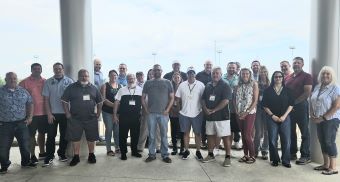Columbus, OH – The United States Trotting Association (USTA), in proud partnership with Eldorado Scioto Downs, successfully hosted the Racing Officials Accreditation Program (ROAP) this past week in Columbus, Ohio. This nationally recognized program is designed to train and certify future harness racing officials, preparing them for critical regulatory and officiating roles at racetracks across North America.
Overseen by USTA Chief Operating Officer TC Lane and USTA Racetrack/Licensing Manager and Corporate Secretary Michele Kopiec, the intensive, week-long seminar ran through June 30 and featured over 60 hours of comprehensive instruction, hands-on exercises, and professional mentorship. The program welcomed a cohort of 28 current and aspiring judges, stewards, paddock supervisors, starters, and other essential racing officials from the U.S. and Canada.
“The accreditation school goes beyond traditional lectures, fostering a dynamic environment where participants actively engage in discussions, observe and participate in practical real-life racing situations,” said Lane. “A significant portion of the educational value is cultivated through the invaluable exchange of ideas among the attending officials – both aspiring and veteran.”

The curriculum encompassed a wide array of essential topics, including the USTA rulebook, pari-mutuel wagering, medication control, ethics, race review protocols, administrative hearings, and public communication.
Program Highlights:
Day One: Introductions to ROAP accreditation and USTA officials’ training, with a presentation on sulky testing and approval. The afternoon featured a joint session with Oregon’s flat racing school via Zoom, where Dr. Jennifer Durenberger, Director of Equine Safety and Welfare for HISA, delivered part one of a seminar on racing law.
Day Two: Associate judge with the Ohio State Racing Commission and recent ROAP graduate John Zawistowski shared insights from his transition from horseman to official, followed by a video media training session with Mark Hebert of the University of Louisville. Dr. Durenberger returned for part two of her racing law seminar to close the afternoon.
Day Three: Steve May, senior executive with Gaming Laboratories LLC, discussed pari-mutuel operations and wagering integrity. Michele Kopiec demonstrated the USTA’s eTrack system, followed by a session from Ohio State Racing Commission veteran presiding judge Doug Thomas on judging duties and responsibilities beyond the stand.
Day Four: Christy Kernik, investigator for the Ohio State Racing Commission, detailed effective collaboration between judges and investigators, highlighting recent cases and investigations. Dr. Mary Scollay, Chief of Science for HIWU, delivered a detailed session on medication testing, thresholds, and chain-of-custody protocols.
Day Five: Students participated in live shadowing of key race-day roles – judge’s stand, photo finish, paddock judge, identifier, starter, mutuels, test barn, and more. The day began with a lecture on communication and professionalism by Thomas Salerno, assistant director of the New Jersey Racing Commission.
Day Six: Pennsylvania Horse Racing Commission presiding judge Scott Egger, along with Salerno, led a full day of harness racing instruction and video review. Jennifer Daniels, administrator of the Standardbred Transition Alliance (STA) emphasized equine aftercare and the importance of post-racing support in the form of rehabilitating, re-training and re-homing Standardbreds.
Day Seven: The final day of instruction focused on a general harness review session led by Egger, and a legal review by retired Executive Director of the Delaware Standardbred Owners Association and now USTA Director Sal DiMario, culminating in oral and video exams.
Day Eight: The final day of the school was dedicated to testing, where students completed comprehensive exams covering general harness racing, legal and medication topics.
“We were honored to host the ROAP school at Scioto Downs and thoroughly enjoyed welcoming such a passionate and dedicated group of future racing officials,” said Jason Roth, director of racing. “We look forward to watching these students grow into key roles within the harness racing industry and are proud to support the development of racing’s next generation of leaders.”
Participants who successfully complete all five exams may become accredited under ROAP standards which may qualify them for licensing as stewards or judges in most major racing jurisdictions.
For more information on accreditation, please visit the ROAP website.
